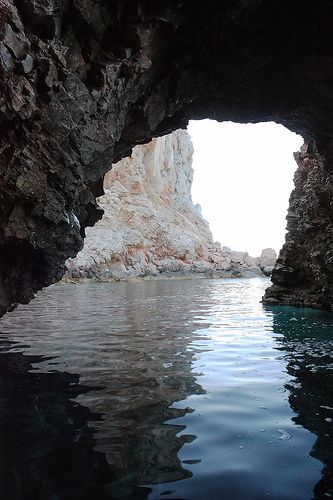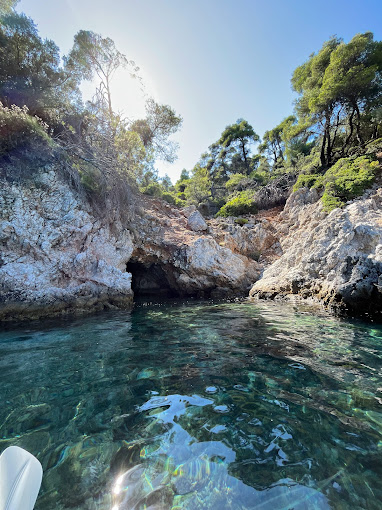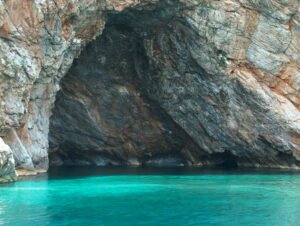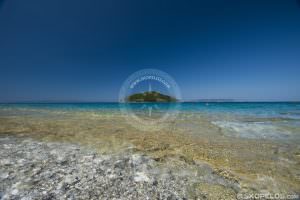SKOPELOS CAVES, THE CAVES OF SKOPELOS, SKOPELOS NATURAL BEAUTIES, TRIPITI CAVE, STAFYLOS CAVE, DASIA CAVE, KASTANI CAVE, CAVE OF CYCLOPS, SKOPELOS DIVE CENTER, SKOPELOS DIVING, SKOPELOS KAYAKING, SUMMER IN SKOPELOS, VISIT SKOPELOS, VACATION IN SKOPELOS, HOLIDAYS IN SKOPELOS, SKOPELOS ISLAND, NORTHERN SPORADES, GREECE, SKOPELOS BLOG, SKOPELOS BLOGSPOT, SKOPELOS BLOGGING, SKOPELOS BLOGS, SKOPELOS BLOGGERS
The Caves of Skopelos and Northern Sporades
Skopelos island has several caves that are worth discovering. The caves are the result of years of erosion caused by the sea and wind. Some of the most well-known caves on the island include:
Tripiti Cave
Tripiti Cave is a natural cave located on the eastern side of Skopelos island, near Skopelos port and Glysteri beach. It is accessible only by boat.
It is not very large, but it is known for its impressive stalactites and stalagmites, as well as its underground lake.

According to local legend, Tripiti Cave was once used as a hideout by pirates who would attack passing ships in the nearby waters. The cave was also used as a shelter by locals during World War II.
It is recommended to wear sturdy shoes and bring a flashlight or headlamp as the cave can be dark in some areas. Visitors should also be aware that the cave can be slippery and uneven in places, so caution is advised when exploring.
STAFYLOS CAVE
Stafilos Cave is a popular tourist attraction located on the Greek island of Skopelos. It is believed to be one of the oldest caves in Greece.
The cave is located about 4 kilometers from the town of Skopelos. It is named after Prince Stafilos, the son of the god Dionysus and Princess Ariadne, who according to legend, used to hide in the cave with his wife and children.

The cave is a natural wonder with stunning rock formations, stalactites and stalagmites, and underground lakes. It is also home to a number of rare and protected species, including bats and freshwater crabs.
DASIA CAVE
The small green island of Dassia is uninhabited and is located opposite the beach Milia. The island offers excellent underwater routes and underwater caves for both diving or kayaking and exploration.
The landscape is lush green and pine-covered. The sea water is clear and blue. The most interesting part is hidden in the unique geological formations.
Divers especially love the Kambuz-Dasia gorge, which is located southwest of the island and has a depth of 100 meters.
Northwest in Dasia is an impressive 40-meter gorge. The second one is deeper so it is recommended for beginner divers.
Finally northeast in the island section is an impressive cave called Lift. Its depth is 35 meters and offers the breathtaking beauty of the Mediterranean sea and underwater landscape.
This small island is associated with a special legend and it is rumored that a well-hidden treasure lies in one of the caves. In the very old days this treasure, which was located in a deep well, is said to have been kept by a nigger who sat on a marble stool and smoked a pipe. But anyone who wanted to obtain the treasure in Skopelos Dassia had to kill a relative first.
Kastani Cave
Kastani Cave is located on the western coast of Skopelos Island in the Northern Sporades, Greece, near the popular Kastani Beach. The cave is accessible only by boat or by swimming from the nearby beach.
Kastani Cave is a small but beautiful cave, known for its crystal-clear waters and unique rock formations. Visitors can swim in the clear waters, explore the cave and admire the impressive stalactites and stalagmites. The cave is surrounded by beautiful natural scenery and visitors can enjoy stunning views of the Aegean Sea.
Kastani Beach, which is located nearby, was made famous by the movie “Mamma Mia!” and is a popular destination for tourists. Visitors can combine a visit to Kastani Cave with a day at the beach, enjoying the sun, sand, and sea.
Cyclops Cave
On the southern side of Skopelos, there is the rocky island of Jura, which today is uninhabited. The archaeologist Adamantios Samson discovered the previously hidden cave of Cyclops in 1992 at an altitude of 150 meters, which is supposed to be the largest cave in the Northern Sporades. The first chamber is located immediately after the entrance to the cave and has dimensions of about 60 x 50 meters while its height is close to 15 meters. The interior of the cave is particularly impressive as beautiful stalagmites and stalactites are formed. These are scattered throughout the cave and have created diverse formations and shades. This excavation provided valuable information about the Mesolithic period that has not been found anywhere else, as well as some remains from earlier times

Nowadays both the Cyclops Cave and the island of Yura are protected areas of Nature Protection. This is because they are home to many endemic species of fauna and flora, and also for the Mediterranean seals (Μonachus Monachus) that live there.
The Cave of Cyclops is a popular attraction located on the south side of Skopelos island, which is part of the Sporades archipelago in Greece. The cave is named after the one-eyed giant Cyclops from Greek mythology.
The Cave of Cyclops is accessible by boat, and visitors can explore the cave by swimming or by boat. The cave has an opening at the top that allows sunlight to filter in, creating a beautiful blue-green glow in the water. The cave is also known for its stunning rock formations and is a popular spot for snorkeling.
Legend has it that the Cave of Cyclops was once home to the giant Cyclops, who would throw rocks at passing ships. The famous Greek hero Odysseus is said to have encountered the Cyclops Polyphemus in a similar cave on the island of Sicily, but there is no evidence to suggest that the Cyclops of Skopelos ever actually existed.
EXTRA TIPS FOR EXPLORING THE CAVES OF SKOPELOS
If you are interested in exploring the caves of Skopelos island, here are some tips that can help make your experience more enjoyable:
- Choose the right cave: Skopelos island has some caves to explore, each with its own unique features and attractions. Research the different options and choose a cave that suits your interests and abilities.
- Consider exploring the caves via Diving or Kayaking: If you are not familiar with caves or are not confident exploring on your own, consider following a diving or kayaking tour since Skopelos offers excellent dive and kayaking center.
- Respect the environment: Caves are fragile ecosystems, so be sure to follow the guidelines for responsible caving. Do not touch or remove any formations, and avoid leaving any litter or disturbing the natural environment.
- Check the weather: Caves can be affected by weather conditions, such as heavy rain or flooding. Check the weather forecast before heading out to explore a cave, and avoid visiting if conditions are not safe.
- Bring your swimming gear and a waterproof camera to capture the beauty of the caves.
Exploring the caves of Skopelos can be a unique and unforgettable experience, as visitors can admire the beautiful rock formations, swim in the crystal-clear waters and enjoy the peacefulness of the surrounding landscape. All the caves are surrounded by beautiful natural scenery, and visitors can enjoy panoramic views of the Aegean Sea. However, it is essential to note that these caves can only be accessed by boat and it is advisable to take necessary safety precautions while exploring them.
Skopelos.com – Skopelos Blog
Blog.Skopelos.com – Skopelos.com/Blog

